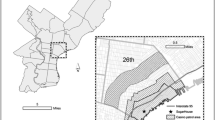Abstract
Research on the relationship between casinos and crime has yielded mixed conclusions. Some authors argue that casinos are crime attractors and provide fertile grounds for disorder in the surrounding communities. Others claim that the impact of casinos on the crime problem has been over-stated and that casinos in themselves are not crime generators. Relying on calls for service and incidents known to the police, this research reveals the specific spatial and temporal characteristics of all criminal and disorderly behaviors around casino venues.







Similar content being viewed by others
Notes
The geocoding rate for the incident was 93%, and 95% for the calls for service.
Since the sum of all the differences would result in a total of zero, the differences were transformed into absolute values and then added to produce the total magnitude difference across a given time point.
References
Albanese, J. (1985). The effect of casino gambling on crime. Federal Probation, 48, 39–44.
Anderson, D., Chenery, S., & Pease, K. (1995). Biting back: Tackling repeat burglary and car crime (pp. 1–57). Police Research Group, Crime Detection and Prevention Series Paper 58.
Barthe, E., & Stitt, B. G. (2007). Casinos as “Hot Spots” and the generation of crime. Journal of Criminal Justice, 30(2), 115–140.
Barthe, E., & Stitt, B. G. (2008). Impact of casinos on criminogenic patterns. Police Practice and Research, 1–15 (iFirst article).
Brantingham, P. L., & Brantingham, P. J. (1995). Criminality of place: Crime generators and crime attractors. European Journal on Criminal Policy and Research, 3(3), 5–26. doi:10.1007/BF02242925.
Chang, S. (1996). The impact of casinos on crime: The case of Biloxi, Mississippi. Journal of Criminal Justice, 24, 431–436. doi:10.1016/0047-2352(96)00029-3.
Cohen, L., & Felson, M. (1979). Social change and crime rate trends: A routine activity approach. American Sociological Review, 44, 588–608. doi:10.2307/2094589.
Curran, J., & Scarpitti, F. (1991). Crime in Atlantic City: Do casinos make a difference? Deviant Behavior, 12, 431–449.
Giacopassi, D., & Stitt, B. G. (1993). Assessing the impact of casino crime in Mississippi. American Journal of Criminal Justice, 18, 117–131. doi:10.1007/BF02887642.
Giacopassi, D., Stitt, B. G., & Nichols, M. (2000). Including population at risk in casino crime rate calculations: What difference does it make? American Journal of Criminal Justice, 24(2), 203–215. doi:10.1007/BF02887593.
Goldstein, H. (1990). Problem-oriented policing. New York: McGraw Hill.
Grinols, E., Mustard, D., & Dilley, C. (1999). Casinos and crime. Paper presented at the annual meeting of the American Law and Economics Association, Yale Law School, New Haven, CT.
Johnson, S. D., & Bowers, K. (2004). The burglary as clue to the future: The beginnings of prospective hot-spotting. European Journal of Criminology, 1(2), 237–255. doi:10.1177/1477370804041252.
Miller, J., & Schwartz, N. (1998). Casino gambling and street crime. Annals, 556, 124–137. doi:10.1177/0002716298556001010.
National Opinion Research Center. (1999). Overview of national survey and community database research on gambling behavior. University of Chicago.
Nelson, A. L., Bromley, R. D. F., & Thomas, C. J. (2001). Identifying micro-spatial and temporal patterns of violent crime and disorder in the British city centre. Applied Geography (Sevenoaks, England), 21, 249–274. doi:10.1016/S0143-6228(01)00008-X.
Ratcliffe, J. H. (2002). Aoristic signatures and the spatio-temporal analysis of high volume crime patterns. Journal of Quantitative Criminology, 18(1), 23–43. doi:10.1023/A:1013240828824.
Ratcliffe, J. H. (2004). The hotspot matrix: A framework for the spatio-temporal targeting of crime reduction. Police Practice and Research, 5(1), 5–23. doi:10.1080/1561426042000191305.
Ratcliffe, J. H., & McCullagh, M. J. (1998). Identifying repeat victimization with GIS. The British Journal of Criminology, 38(4), 651–662. doi:10.1093/bjc/38.4.651.
Ratcliffe, J. H., & McCullagh, M. J. (1999). Hotbeds of crime and the search for spatial accuracy. Journal of Geographical Systems, 1, 385–398. doi:10.1007/s101090050020.
Roncek, D., & Mayer, P. (1991). Bars, blocks and crime revisited: Linking the theory of routine activities to the empiricism of ‘hot spots’. Criminology, 29, 725–753. doi:10.1111/j.1745-9125.1991.tb01086.x.
Sherman, L., Gartin, P., & Buerger, M. (1989). Hot spots of predatory crime: Routine activities and the criminology of place. Criminology, 27, 27–55. doi:10.1111/j.1745-9125.1989.tb00862.x.
Stitt, B. G., Nichols, M., & Giacolassi, D. (2003, April). Does the presence of casinos increase crime? An examination of casino and control communities. Crime and Delinquency, 49(2), 253–284.
Thompson, W., Gazel, R., & Rickman, D. (1996). Casinos and crime in Wisconsin. Wisconsin Policy Institute Report, 9(9), 1–20.
Townsley, M., Homel, M., & Chaseling, J. (2000). Repeat burglary victimization: spatial and temporal patterns. Australian and New England Journal of Criminology, 33(1), 37–63.
Weisburd, D., & Greene, L. (1995). Policing drug hotspots: The Jersey City drug market analysis experiment. Justice Quarterly, 12, 711–735. doi:10.1080/07418829500096261.
Weisburd, D., & Mazerolle, L. G. (2000). Crime and disorder in crime hot spots: Implications for theory and practice in policing. Police Quarterly, 3(3), 331–349. doi:10.1177/1098611100003003006.
Author information
Authors and Affiliations
Corresponding author
Rights and permissions
About this article
Cite this article
Barthe, E., Stitt, B.G. Temporal Distributions of Crime and Disorder in Casino and Non-Casino Zones. J Gambl Stud 25, 139–152 (2009). https://doi.org/10.1007/s10899-009-9115-2
Received:
Accepted:
Published:
Issue Date:
DOI: https://doi.org/10.1007/s10899-009-9115-2




